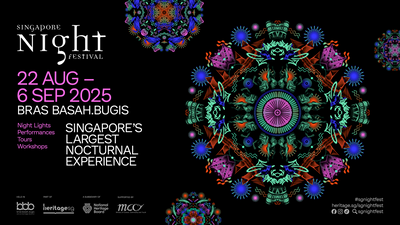Featuring a selection of artefacts from the museum’s collection that explores the little-known side of Singapore’s history of public health crises and responses, the exhibition will be launched on the National Museum's website from 18 September 2020.

Photo Credit: National Museum of Singapore
Every Body Plays a Part: A Showcase of Public Health Crises and Responses in Singapore will provide insights into Singapore’s past experiences with infectious diseases and public health issues and observes how some of these measures are still undertaken to manage the COVID-19 pandemic today.
Drawing from the National Museum’s rich collection, Every Body Plays a Part presents 39 artefacts and one newly-commissioned photograph. The photograph and 35 of the artefacts have not been displayed in the National Museum’s galleries before. The fresh narrative highlights the measures taken to stem the spread of contagious diseases on the island, the introduction of vaccines, the creation of hospitals and the roles played by key local personalities such as Dr Lim Boon Keng and Tan Tock Seng, as well as the public campaigns aimed at encouraging a clean and hygienic environment – the effects of which are still prevalent today.
This online showcase by the National Museum of Singapore aims to not only reflect on but also respond to key events that have happened – and are happening – in Singapore, and through this, inspire conversations and connections among Singaporeans.
More so with the ongoing COVID-19 pandemic, Every Body Plays a Part seeks to serve as a timely response, and with hopes that through this, the people of Singapore will take heart that what is now considered the ‘new normal’ has been experienced in some form in the past, and that we Singaporeans will get through this crisis, just as we have before.
Every Body Plays a Part will feature four exhibits:
Exhibit A: The Distancing of Bodies
This exhibit introduces one of the earliest accounts of social distancing and the practice of quarantine in Singapore through artefacts dating back to the early 19th century. As passengers onboard ships often carried infectious diseases such as cholera, smallpox and measles, ports functioned as control zones to restrict the influx of such illnesses.

Postcard titled “St John’s Island”, Straits Settlements c1908
Photo Credit: National Library Board
This coloured postcard shows immigrants with their belongings at the port on St John’s Island. From the 1900s, thousands of passengers and crew members passed through the island each year, where they were screened, quarantined and treated before being sent to Singapore. St John’s Island was fully equipped as a quarantine station by the 1930s, complete with modern store houses containing sulphur to fumigate ships, muster sheds for immigrants to change their clothes and shower, and hospitals and laboratories with vaccines stored in cooling chambers.
Exhibit B: The Inoculation of Bodies
This exhibit features artefacts and documents related to vaccination practices and policies in Singapore over the years. Infectious diseases such as cholera, diphtheria and tuberculosis that were common were treated with vaccinations.

Certificate of BCG testing and vaccination c1962
Photo Credit: Roots.sg
Since the mid-1950s, this slip of paper has come to mark a rite of passage for Primary Six schoolchildren in Singapore, as is the resultant mark on their arm. The Bacille Calmette-Guérin (BCG) vaccination is meant to provide immunisation against tuberculosis meningitis among children.
The BCG vaccination was first introduced in Singapore in 1957, but was met with initial reservations within the medical community. In 1959, Dr N. C. Sen Gupta, Medical Director of Singapore’s Anti-Tuberculosis Association, wrote to The Straits Times to express his concern should BCG vaccination be made compulsory, since the medical research behind the BCG was fairly new at the time. However, the efficacy of BCG vaccinations soon allayed these concerns.
In the past, children were required to receive BCG injections twice: once at the infant stage, with a revaccination done by health officials in schools about 12 years later. However, since 2001, BCG revaccination has been phased out by the Ministry of Health.
Exhibit C: The Hygiene of Bodies
This exhibit explores the contributions of Dr Lim Boon Keng, one of Singapore’s pioneering social reformers, as well as the role of playgrounds and public campaigns in helping Singaporeans cultivate good hygiene habits to safeguard public health, and to stay active and healthy.

“Hawkers and The Health Law” booklet c1980s
Photo Credit: Roots.sg
Between the early 1970s and 1980s, Singapore food vendors relocated to hawker centres as part of the government’s efforts to promote public hygiene and keep Singapore clean. This illustrated 1980s booklet marks the government’s efforts at promoting public hygiene to hawkers, especially against gastro-intestinal infections such as cholera, dysentery and typhoid. It includes instructions on maintaining good hygiene and a clean environment, as well as information on the penalty for failing to adhere to the suggestions.
Severe Acute Respiratory Syndrome (SARS), the highly contagious viral infectious disease, broke out in Singapore in early 2003. SARS was caused by the SARS coronavirus. Like COVID-19, it caused breathing problems, with the infected developing a high fever with chills. People were encouraged to monitor their temperatures regularly. Other measures implemented at the time, which seem very similar to the ones practised today, included wearing a mask, covering one’s face when coughing, washing one’s hands regularly and keeping a clean environment.
Exhibit D: The Restoration of Bodies
This exhibit showcases images related to early hospitals and medical halls that played a major role in helping the sick. It also features non-medical options that have been used to restore one’s health over the years, some of which are still available today. The COVID-19 virus that has afflicted millions globally has made us acutely aware of the fragility of our bodies, and ignited a race against time to find a cure. Attempts to develop vaccines to shield ourselves against the infection continue to be made across the world.

Image of Tan Tock Seng Hospital c1876
Photo Credit: Roots.sg
This photograph shows the second site of Tan Tock Seng Hospital at Serangoon Road near the junction of Balestier Road. Built with a generous donation by the philanthropist Tan Tock Seng in 1844, the first hospital was located in Pearl’s Hill and called the Chinese Pauper Hospital.
The hospital moved several times over the years, before shifting to its current location in Novena in 2000. Its site at Balestier-Serangoon was handed to the Cantonese community to build the Kwong Wai Shiu Hospital.
After transitioning into a general hospital, Tan Tock Seng Hospital has achieved many firsts in the fields of neurology, cardiology, rheumatology and geriatrics in Singapore. During the Severe Acute Respiratory Syndrome (SARS) outbreak in 2003, the hospital served as a quarantine facility to treat infected patients.
As part of its public engagement efforts to broaden Singapore’s contemporary collection, the National Museum also invites residents in Singapore to contribute objects and accompanying stories and photos to its ongoing Collecting Contemporary Singapore: Documenting COVID-19 in Singapore initiative. For more information or to submit a contribution, click here.
The public may also visit the National Museum’s Facebook and Instagram pages to learn more and participate in interesting activities, such as submitting their stories to our very own BCG Diaries, to complement their exhibition experience.







